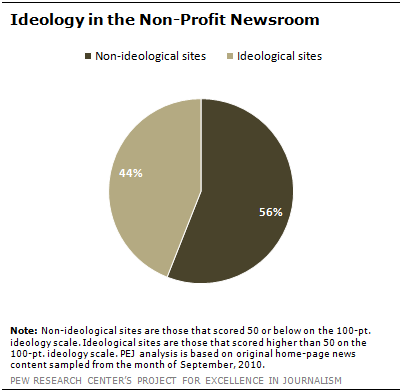Assessing a New Landscape in Journalism
By Jesse Holcomb, Tom Rosenstiel, Amy Mitchell, Kevin Caldwell, Tricia Sartor and Nancy Vogt
A new phenomenon has emerged in journalism in recent years-the era of non-profit news.
As traditional newsrooms have shrunk, a group of institutions and funders motivated by something other than profit are entering the journalism arena. This distinguishes them from the commercial news institutions that dominated the 20th century, whose primary sources of revenue-advertising and circulation-were self-evident.

Who are these new players in journalism? Are these sites delivering, as they generally purport to be, independent and disinterested news reporting? Or are some of them more political and ideological in their reporting? How can audiences assess this for themselves? In short, what role are these operations playing in the changing ecosystem of news?
[1]
(There is a larger universe of community-level non-profit news operations perhaps even more diverse in nature. That group is beyond the scope of this analysis, but does bear further study.)
The 46 national and state-level news sites examined-a group that included seven new commercial sites with similar missions-offered a wide range of styles and approaches, but roughly half, the study found, produced news coverage that was clearly ideological in nature.
In general, the more ideological sites tended to be funded mostly or entirely by one parent organization-though that parent group may have various contributors. They tended to be less transparent about who they are and where their funding comes from. And they tended to produce less content-in some cases generating one or two stories per week produced by a single staffer.
Sites that offered a mixed or balanced political perspective, on the other hand, tended to have multiple funders, more revenue streams, more transparency and more content with a deeper bench of reporters. The six most transparent sites studied, for instance, were among the most balanced in the news they produced.
[3]
These are among the findings of the study, which examined 46 news websites and an additional 68 institutions and individuals that provide the primary financial support for those sites. Researchers analyzed a total of 1,203 stories sampled from the month of September 2010 and conducted an audit of the sites and their chief supporters between the months of May 2010 and September 2010.
The non-profit sites studied, 39 in all, fell naturally into three basic types based on the nature of their funding and the level of independence of their organizations. There were Group Sites, those that were part of formal families organized by a single parent or funder. There were Associated Sites, those that shared content with each other but otherwise operated independently and for the most part had different funders from one another. There were Individual Multi-Funder Sites, which each had multiple funding sources and revenue streams and operated entirely independently. In addition, there were sevenCommercial Sites that fit all the other criteria of the study except that they operated as for-profit concerns, and as such offered a basis of comparison. (There were also two sites that were Outliers in that they were independent sites but had a few funders, and thus did not fit the categories above.)
Among the findings:
- The most ideological sites were Group Sites, those that belonged to one of two families organized by a sole or primary funder. One was a family of nine liberal sites that all have the word “Independent” in their names, funded chiefly by theAmerican Independent News Network. The other was a group of 12 conservative sites that share the name“Watchdog” and are funded chiefly by the Franklin Center for Government & Public Integrity, which was launched in part by a libertarian group called the Sam Adams Alliance.
- The least ideological in their content were sites that operated entirely on their own and had multiple funding sources and revenue streams, sites such as The Texas Tribune (which lists 12 foundations among its dozens of “founding investors,” as well as 64 corporate sponsors and hundreds of individual donors, and generates revenue from events and other revenue devices) and Connecticut Mirror (which lists 10 supporting foundations). These sites also tended to be more transparent and generate a relatively high volume of content.
- One striking feature across many of the news sites studied was that while they may have been forthcoming about who their funders were, often the funders themselves were much less clear about their own sources of income. This effectively made the first level of transparency incomplete and shielded the actual financing behind the news site. The chief funders listed for nearly two-thirds of the sites studied-28 in all-did not disclose where their money came from.
- Reporting resources in this emerging category of news operations tended to be quite limited. All the sites in the study had some staff and all produced original content at least weekly. The median was eight stories per week, but some averaged as few as one or two. And, of the 46 sites studied, the median reporting and editorial staff numbered just three people. At 18 sites-more than a third of those studied-just one or two people authored all of the stories analyzed.
- Whether by design or due to resource limitations, the majority of news stories on these sites presented a narrow range of perspectives on the topics covered. Overall, half of the news stories studied (50%) offered just a single point of view on controversial issues. Just 2% of stories contained more than two points of view.
- The topics covered on these sites often correlated with the political orientation of the sites and their backers. The more liberal-oriented American Independent News sites, for instance, heavily favored stories about the environment and organized labor, topics that did not appear among the most-covered for other groups of sites. The more conservative Watchdog.org sites, on the other hand, often set their focus on the government system itself, drawing attention to stories of inefficiency and waste.
This study is a first attempt to empirically evaluate a new sphere in journalism, but it is only a beginning and only a part of that sphere. Inevitably, studies such as these are snapshots in time. Two of the outlets studied have folded since our research took place: the Washington Independent and North Carolina Independent News. Others may have emerged since the audit was conducted. In addition, some of the sites included in this analysis, as they develop and try to achieve more credibility, may become more transparent about their patrons and perhaps more even-handed in their coverage. Some sites may have adopted new sources of funding or shed old ones.
The information gleaned by researchers about these news organizations and their funders was limited to information that was available on their websites-the same information that typical news consumers are limited to. The researchers often went further than the average citizen might-several layers deeper to find out about parent organizations and their funding.
The study finds that the fact that a news site is a non-profit does not define what kind of news it produces. Some fit squarely into the traditions of independent news gathering, which dictates offering a wide range of perspectives and ideas about current events. Others fall more closely toward what might be considered partisan news or even political activism.
Certainly consumers can find partisan content in traditional commercial media as well, increasingly so as the range of outlets has grown in the digital age. But those commercial sites, usually national in scope, often have gotten more scrutiny than many of the news operations in this study, particularly those sites offering content at the state level. Many of the sites examined here, moreover, purport that they were started precisely to fill the gap left at the state level from cutbacks in traditional media, especially newspapers, and thus present themselves as functioning much as traditional media once did.
Given that the financing of non-profit news is not self evident in the same way it is in commercial media, however, it is not so obvious where the financing for these sites comes from and what the motivations behind the financing are. This study also offers some guidance for consumers about how they can assess the nature of non-profit news sites content and the level of transparency the site has about its mission and funding.
[1]
[2]
[3]




